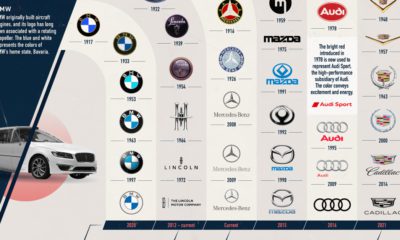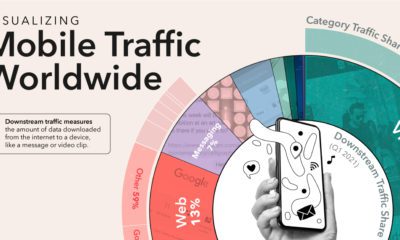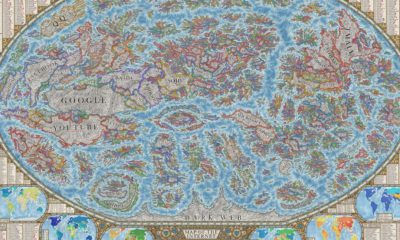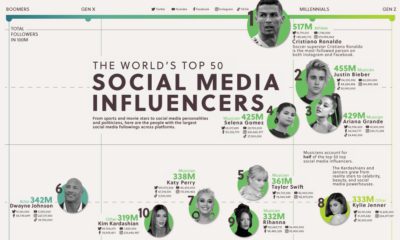Forgot about becoming an astronaut—these days, kids are three times more likely to dream of becoming a professional YouTuber. And who can blame them? With a big enough fan base, vlogging can be a lucrative business. Who exactly are these professional content creators, and how do they make their money? This graphic by Accredited Debt Relief shows the most popular YouTuber in nearly every country. The list only considers individual YouTubers, so brands, bands, or shows didn’t make the cut.
How Do YouTubers Make Money?
Before diving into the list, it’s important to understand the basics of the business. How do these content creators generate revenue?
Advertisements If a YouTuber reaches 1,000 subscribers and 4,000 watch hours within a year, they can start to monetize their account with advertisements. YouTubers only get paid when a viewer watches the full ad, or clicks on it. YouTube Premium This is a monthly subscription service that allows fans to watch their favourite content without ads. YouTubers get a cut of subscription profits, based on how many views their channel attracts. Corporate Sponsorships Also known as influencer marketing, this is when brands pay content creators to promote their product. A vlogger typically needs a large following before brands are willing to work with them, but expectations from brands vary based on the company and their marketing objectives. Merchandise Sales If an influencer has a loyal fan base, they can make a pretty penny selling branded swag. It’s estimated that PewDiePie, the world’s most popular YouTuber, makes over $6 million a month from merch sales.
While there are several options for making money on YouTube, it’s nearly impossible to make a living without a large following.
The Full Breakdown
With over 50 million content creators on YouTube, getting noticed is no easy feat. Here’s a look at the most popular YouTubers in 187 different countries, based on their total subscribers: *Note: Estimated earnings were calculated via NoxInfluencer. Actual earnings may vary. As mentioned earlier, the world’s most popular YouTuber is Swedish-born vlogger PewDiePie. He’s well known for his “Let’s Play” videos, which document him playing various video games. PewDiePie joined YouTube in 2010, and has now amassed 105 million subscribers. While he’s based in England, his channel is registered under the United States. It’s worth noting the vast discrepancies between certain countries. For example, while the U.S.’s most popular YouTuber, Like Nastya boasts 57 million subscribers, Eswatini’s top vlogger, OuSSama MiZani has less than 800. Clearly, some markets are more saturated than others.
Categories, Ranked by Popularity
Geography isn’t the only factor that impacts popularity—the type of content is important as well. Which 10 categories do the top earning YouTubers fall into? Not surprisingly, the most popular category is entertainment, which has 72 of the top earning YouTubers. Some of the biggest YouTube personalities fall under this category, such as PewDiePie and Chilean YouTuber HolaSoyGerman, who has 41 million subscribers. The second most popular category is gaming, which has 25 of YouTube’s top earners. Some big names in this category include Ireland’s jacksepticeye with 24.7 million subscribers, and Canada’s VanossGaming, who has 25.2 million. In third place are “How To” videos—18 of the 187 top earners fall into this category. Life Hacks & Experiments is the most popular YouTuber in this group, with 8.3 million subscribers.
Categories, Ranked by Earnings
Here’s the highest earning YouTuber on this list for each category. When ranked by monthly earnings, the kids category comes in at first place. Six-year-old Like Nastya makes an estimated $7.73 million per month—that’s over 5 million more than the second ranking category, which is entertainment. The third most lucrative category is gaming, with the highest earner, jacksepticeye grossing an estimated $990,000 a month. It’s important to note that figures are estimates of each YouTuber’s ad revenue, so it doesn’t account for corporate sponsorships, merchandise sales, or any fan donations. So for all we know, these influencers could be making even more money. If that doesn’t inspire you to start posting amateur videos on YouTube, we don’t know what will. on Even while political regimes across these countries have changed over time, they’ve largely followed a few different types of governance. Today, every country can ultimately be classified into just nine broad forms of government systems. This map by Truman Du uses information from Wikipedia to map the government systems that rule the world today.
Countries By Type of Government
It’s important to note that this map charts government systems according to each country’s legal framework. Many countries have constitutions stating their de jure or legally recognized system of government, but their de facto or realized form of governance may be quite different. Here is a list of the stated government system of UN member states and observers as of January 2023: Let’s take a closer look at some of these systems.
Monarchies
Brought back into the spotlight after the death of Queen Elizabeth II of England in September 2022, this form of government has a single ruler. They carry titles from king and queen to sultan or emperor, and their government systems can be further divided into three modern types: constitutional, semi-constitutional, and absolute. A constitutional monarchy sees the monarch act as head of state within the parameters of a constitution, giving them little to no real power. For example, King Charles III is the head of 15 Commonwealth nations including Canada and Australia. However, each has their own head of government. On the other hand, a semi-constitutional monarchy lets the monarch or ruling royal family retain substantial political powers, as is the case in Jordan and Morocco. However, their monarchs still rule the country according to a democratic constitution and in concert with other institutions. Finally, an absolute monarchy is most like the monarchies of old, where the ruler has full power over governance, with modern examples including Saudi Arabia and Vatican City.
Republics
Unlike monarchies, the people hold the power in a republic government system, directly electing representatives to form government. Again, there are multiple types of modern republic governments: presidential, semi-presidential, and parliamentary. The presidential republic could be considered a direct progression from monarchies. This system has a strong and independent chief executive with extensive powers when it comes to domestic affairs and foreign policy. An example of this is the United States, where the President is both the head of state and the head of government. In a semi-presidential republic, the president is the head of state and has some executive powers that are independent of the legislature. However, the prime minister (or chancellor or equivalent title) is the head of government, responsible to the legislature along with the cabinet. Russia is a classic example of this type of government. The last type of republic system is parliamentary. In this system, the president is a figurehead, while the head of government holds real power and is validated by and accountable to the parliament. This type of system can be seen in Germany, Italy, and India and is akin to constitutional monarchies. It’s also important to point out that some parliamentary republic systems operate slightly differently. For example in South Africa, the president is both the head of state and government, but is elected directly by the legislature. This leaves them (and their ministries) potentially subject to parliamentary confidence.
One-Party State
Many of the systems above involve multiple political parties vying to rule and govern their respective countries. In a one-party state, also called a single-party state or single-party system, only one political party has the right to form government. All other political parties are either outlawed or only allowed limited participation in elections. In this system, a country’s head of state and head of government can be executive or ceremonial but political power is constitutionally linked to a single political movement. China is the most well-known example of this government system, with the General Secretary of the Communist Party of China ruling as the de facto leader since 1989.
Provisional
The final form of government is a provisional government formed as an interim or transitional government. In this system, an emergency governmental body is created to manage political transitions after the collapse of a government, or when a new state is formed. Often these evolve into fully constitutionalized systems, but sometimes they hold power for longer than expected. Some examples of countries that are considered provisional include Libya, Burkina Faso, and Chad.













